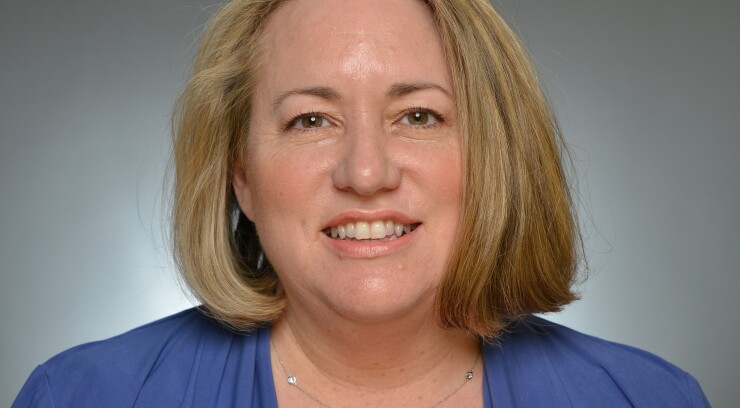Want unlimited access to top ideas and insights?
Complimentary access to top ideas and insights — curated by our editors.
After two months of lackluster bond issuance, more than half of market participants in a Bond Buyer live market survey believe 2022 issuance will be less than the last two record years.
Given issuance
“When I looked at the volume forecast [in December], it was anywhere from $440 billion to $550 billion, but clearly so far this year, it's been a different market and volume is off this year,” Rick Kolman, managing director and head of Municipal Securities Group at Academy Securities, said at The Bond Buyer National Outlook conference Tuesday during a live market survey, sponsored by Fitch Ratings. “There is a good reason to say that it's going to be less than last year, and some revised their forecasts to be $425 billion to $450 billion.”
Kolman, though, remains somewhat optimistic. If the market stabilizes and the money calendar, which has been very weak this year so far, starts to pick up, everybody may be wrong.
Some agreed with Kolman’s optimism, as 17% think 2022 issuance will be about the same as 2020 and 2021, while 14% believe issuance for this year will exceed 2020 and 2021. Additionally, 12% believe issuance totals will be subject to market conditions. Predictions are difficult given current conditions.
Part of those initial $500-billion-plus forecasts for 2022 stemmed from the belief taxable issuance, especially taxable advanced refundings, would take off as it did last year.
In 2021, taxable issuance was just shy of $120 billion, about 20% of the total issuance for the year. Tax-exempt advanced refundings have not been reinstated and taxable issuance was down 80% year-over-year in February, prompting a majority (70%) to believe taxable issuance will be less than 2021. However, some (22%) believe taxable issuance will be about the same as last year, while a few (8%) think it will be more than 2021.
“We do see taxable issuance decreasing this year, and I think it's a big shame,” said Marcus Peters, director of Stifel, Nicolaus & Co. “Taxable issuance has led the conversation on [environmental, social and governance factors]. Taxable buyers from Europe, as well as nontraditional muni buyers, have used taxable municipal bonds to participate in some of the ESG conversation, so a decrease in that can potentially slow down what would have been a very robust market in ESG.”
Despite this, nearly half (52%) think there will still be a significant acceleration in the growth of ESG-labeled/designated issuance in the next two to five years, given the growing focus on ESG factors. Some (38%) think there will be a moderate acceleration in growth, while a few (10%) said this will have no impact on growth.
“I’d like to see the moderate acceleration in growth, and I think the whole ESG topic over the last few years has really been a hot topic in municipal finance,” said David Erdman, capital finance director for the state of Wisconsin.
But with that growth comes
David Womack, deputy director of financing policy and coordination for the New York City Office of Management and Budget, disagreed with the majority, citing inflation/rising interest rates as having the biggest impact on the public finance industry in 2022. Thirty-two percent of respondents agreed with Womack.
“ESG is a secondary factor,” he said. “There are disclosure issues that are going to be raised by that sector, but as a direct impact on the industry itself, I lean more toward inflation and general economic conditions.”
Recent economic conditions, specifically the continued market volatility, have played a prominent role in the muni market. Rates, for one, have been on the rise since the beginning of the year. As of Wednesday, on a year-to-date basis, the muni five-year has increased 71 basis points, the 10-year rose 55 basis points and the 30-year increased 49 basis points, according to ICE Data Services.
Over the next six to 12 months, 69% said rates will rise while 16% think rates will fluctuate. Only 5% said rates will fall, and 10% think muni rates will stabilize once the first rate hike is done.
Many experts estimated the Federal Reserve will raise interest rates four to five times this year and predicted a 50 basis point rate hike at the March Federal Open Market Committee meeting. However, due to recent geopolitical tensions following Russia’s invasion of Ukraine, there’s greater uncertainty around the Fed’s plans, though Federal Reserve Chair Jerome Powell said Wednesday he supports a quarter-point increase at the March meeting.

Erdman believes muni rates will increase over the next few months, just not as much as some analysts are predicting.
“How many times over the last 12, 15 years have we said rates are going to be up and you get to Dec. 31 and rates actually end up being down?” he asked. “Yeah, there's some different pressures right now, but I've lost that bet a few times in my time. So we're waiting to see, but I don't think the rates are going to go up as fast as people are projecting.”
In 2021, rating upgrades outnumbered downgrades. For this year, 62% answered there would be a relative balance between upgrades and downgrades, 35% said upgrades will outnumber downgrades and 3% think downgrades will outnumber upgrades.
“We're anticipating fairly stable upgrades versus downgrades this year,” said Arlene Bohner, head of Fitch Ratings' U.S. Public Finance Department. “For 2022, our sector outlooks are all neutral, which means that we think that the general operating conditions are going to be neutral to what was a surprisingly strong 2021.”
Bohner also said Fitch anticipates economic growth will slow in 2022 but will still be supportive of positive credit conditions. State and local government credit conditions have improved dramatically, helped along by better-than-expected tax revenues and federal aid.
In the next six to 12 months, respondents believe inflation (59%) and federal stimulus (25%) will have the greatest impact on issuer credit.
Panelists disagreed with the survey participants, though, believing labor pressure, which can be tied to inflation and federal stimulus, is a bigger issue for issuer credit, of while only 6% of respondents said that.
“Obviously, inflation is a big driver, because that can come in a number of different ways,” Womack said. “But as an issuer, one of the things that I think to be more pressing is labor pressure, particularly in northeastern states that are highly unionized.”
“Issuers are going to want to do more projects and find the labor to help keep up with those projects is going to be a challenge,” Erdman said.
Participants also voted on how technology will affect the industry. In the next five years, 55% believe technologies, such as electronic trading, artificial intelligence and machine learning, will become a larger part of the municipal market. Thirty-two percent said it will take longer than five years, and 13% think the municipal market isn’t a good fit for these types of technologies.
Using these technologies may not work for everything. For one, it could be difficult to handle deals less than $10 million from a technology standpoint, Kolman said.
But overall, most panelists agree advances in technology and machine learning will make things easier.
“In five years I'll be pricing bonds in the Metaverse,” Peters said. “I definitely think technology has a huge role play.”





